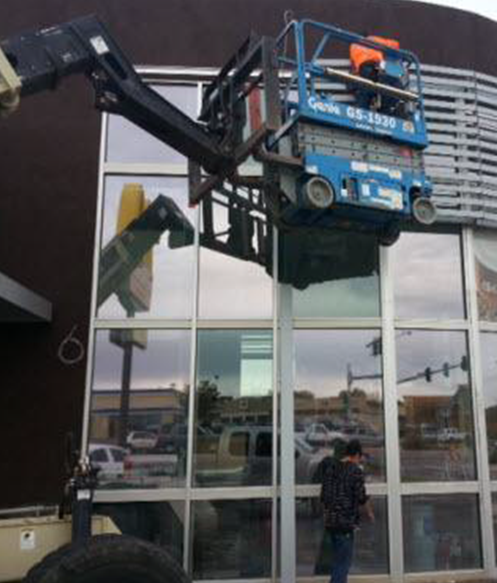
Which of the people in this picture is in a hazardous position and why’

Elevated work platforms, such as boom and scissor lifts, are useful pieces of equipment that can give workers safe access to otherwise inaccessible areas. But they have to be used correctly or they pose a danger to the workers operating them’and other workers in the area.
For example, in this picture from the Naval Safety Center, the worker at the bottom of the picture shouldn’t be underneath the boom lift. In that position, he’s at risk of being hit by materials or tools falling off the platform. And if the lift should collapse or fall over, he could be crushed underneath it or struck by it as it falls.
Example: Two workers in Ontario were repairing a broken beacon on a cement median between four lanes of traffic. One worker was in the bucket of a boom truck extended over a lane of traffic next to the median; the other was standing on the median. A bus struck the boom. The worker on the median was hit and killed by the bus and the bucket as it fell to the ground. The other worker was injured. The company pleaded guilty to failing to ensure that a traffic protection plan was in place. The court fined it $150,000 [Stacey Electric Company Ltd., Govt. News Release, Nov. 21, 2012].
15 Boom Lift Safety Tips
The OHS laws regulate the use of boom lifts and other types of elevating work platforms. For example, many jurisdiction’s OHS regulations incorporate CSA standard CAN3-B354.4 Boom-Type Elevating Work Platforms. As always, you should check the specific requirements in your jurisdiction and comply with them. But here are some general safety tips for this equipment:
1. Ensure that workers who operate boom lifts and other elevating work platforms are properly trained in the safe use of the equipment to ensure that they’re competent. (For information on who qualifies as a ‘competent person,’ see ‘Compliance 101: What Makes a Worker a ‘Competent Person’ under OHS Laws’‘)
2. Maintain boom lifts in accordance with the manufacturer’s instructions. To that end , the equipment should be inspected prior to use each day. You can use this elevating work platform inspection checklist.
3. All overhead dangers, such as joists, beams and power lines, should be identified, controlled or otherwise addressed prior to the start of work.
4. Objects, materials or tools with the potential of falling from the lift should be adequately secured.
5. Don’t exceed the load limits of the equipment. Allow for the combined weight of the worker, tools and materials.
6. Workers should board or exit a boom lift in accordance with the manufacturer’s instructions.
7. Never move the equipment with workers in an elevated platform unless it’s permitted by the manufacturer.
8. The travel path should be clear of all hazards, such as ditches, drop offs, holes, bumps, debris or any other potential obstructions.
9. Maintain a minimum clearance of at least three meters from any overhead lines.
10. Always treat power lines, wires and other conductors as energized, even if they’re down or appear to be insulated.
11. Ensure workers use appropriate fall protection, such as a body harness or restraining belt with a lanyard attached to the platform, to prevent them from falling or being ejected or pulled from the platform.
12. Workers shouldn’t sit or climb on the guardrail of the basket/platform.
13. Workers shouldn’t use boom lifts in extreme weather conditions, such as thunderstorms, heavy rain, extreme heat or cold, unless provisions have been made to ensure their safety and /or protection or when winds exceed the manufacturer’s recommendations.
14. Equipment should generally be operated on a firm, level surface capable of withstanding the weight and all forces applied by the machine, taking into account unseen hazards such as underground vaults, storage tanks, etc. Wheel chocks should be used when parked on inclined surfaces.
15. When operating a boom lift in areas of vehicular traffic, proper signage should be in place and flaggers or traffic control workers should be used as required. (Learn about traffic control plans.)
Download this model safe work procedure for powered aerial work platforms and adapt it for your workplace, OHS program and your jurisdiction’s OHS laws as they relate to such equipment.
